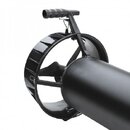Pavao
Contributor
- Messages
- 656
- Reaction score
- 326
Hmm, I also have an H160, I believe there's at least 2 versions of it, one with the LED on nose (older/1st version) and another (later version) where the LED light is no longer present, is that correct, can anyone confirm?
Mine is the one with the LED, it has a metal handle (half ring) on the nose, it also came with cam band handle strap to be attached to the body for carrying, the metal ring is kinda thin and not so comfortable to use, I'm guessing that's why the additional handle was provided for installation. When I first got it, for the first few times I used it with the cam band handle provided, installed, what I remember is that it's buoyancy was solid neutral and trim was perfect.
I didn't like how the cam buckle set on the scooter though, so I quickly rigged my own version of it, all I did was cut the buckle off and use 4 clamps to secure the handle back in, I could not find large enough clamps, so I attached 2 together to get enough diameter, worked really well and is a lot "cleaner" and slick than the cam buckle.
That however, affected the trim, it is now slightly nose light, the buoyancy difference is pretty neglectable though.
I was on deco one day, and I looped the tow cord around the anchor line we were drifting on, it wouldn't move, I gave it several pushes upward to send it to the surface (I was on the 20' stop), it sits in a 50 - 60 degre angle nose up.
This is all in salt water.
Now, I know I need to remove some weight to use it in fresh water, and those weights sit fairly up towards the nose, seems like a PITA job to get it trimmed and neutral for fresh water, and I'm taking this to the caves pretty soon.
John, have you used yours since September? And, is yours like mine, with the LED on nose?
Mine is the one with the LED, it has a metal handle (half ring) on the nose, it also came with cam band handle strap to be attached to the body for carrying, the metal ring is kinda thin and not so comfortable to use, I'm guessing that's why the additional handle was provided for installation. When I first got it, for the first few times I used it with the cam band handle provided, installed, what I remember is that it's buoyancy was solid neutral and trim was perfect.
I didn't like how the cam buckle set on the scooter though, so I quickly rigged my own version of it, all I did was cut the buckle off and use 4 clamps to secure the handle back in, I could not find large enough clamps, so I attached 2 together to get enough diameter, worked really well and is a lot "cleaner" and slick than the cam buckle.
That however, affected the trim, it is now slightly nose light, the buoyancy difference is pretty neglectable though.
I was on deco one day, and I looped the tow cord around the anchor line we were drifting on, it wouldn't move, I gave it several pushes upward to send it to the surface (I was on the 20' stop), it sits in a 50 - 60 degre angle nose up.
This is all in salt water.
Now, I know I need to remove some weight to use it in fresh water, and those weights sit fairly up towards the nose, seems like a PITA job to get it trimmed and neutral for fresh water, and I'm taking this to the caves pretty soon.
John, have you used yours since September? And, is yours like mine, with the LED on nose?





